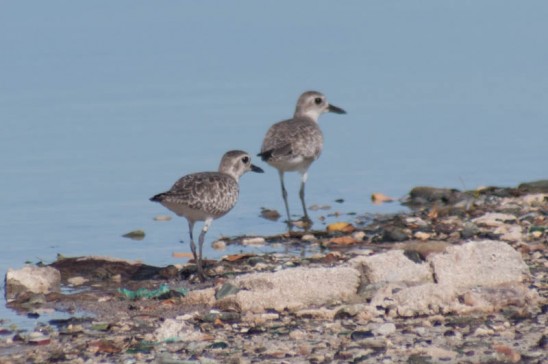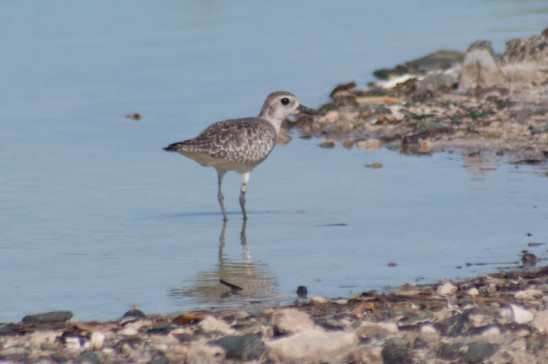November 22nd, 2011 by Marc AuMarc
This year’s sargassum invasion has raised loads of questions: Why is it happening? When will it end? Will the beaches be clear by the time tourists arrive for the high season? Today I’ve been wondering how it will impact the coastal vegetation.
Even in areas where the sargassum seems greatly reduced compared to earlier in the year, it’s secretly still there. Even some beaches that look mostly sandy right now actually have alternating layers of sand and decomposing sargassum built up over the summer and fall. Until it is totally decomposed and washed out to sea by the action of the waves, it seems possible that these nutrients might make the beaches could be more hospitable to the salt-tolerant plants that already live near the shore.
If sargassum floats in continuously or in more frequent waves, perhaps beach sand would gradually turn into something more like a sandy soil. Coastal grasses, beach morning glory, sea grapes, palms and mangroves might be able to move down the beach. If something along these lines did happen, what kinds of impact would it have?
For now, as you can see below, there are just a few small plants sprouting up amongst the sargassum, and perhaps they would have been able to grow in these spots even on a regular year. Only time will tell.
Posted in Les Fruits sur la Terre, Marine Ecology, Pour les Sciences
Comment on this post.
November 21st, 2011 by Marc AuMarc
Étang Chevrise, a large pond between Orient Bay and Cul-de-Sac, has been home to dozens of brown pelicans this year. Below are a few photos of the pelicans, as well as a few ducks and black-necked stilts. In addition to the birds pictured below, there were plenty of herons and a huge flock of black-necked stilts there yesterday afternoon. If you get the urge to check out the birds on the pond, the best spots are behind the Cadisco gas station and along the road to Boo Boo Jam.
Posted in Explorations, Les Fruits sur la Terre
Comment on this post.
November 21st, 2011 by Marc AuMarc
Catching the bus on a Sunday can take a while. Luckily, I was waiting near a small palm tree that was home to at least five different species of spider from at least three different families. That’s quite a bit of spider diversity for one tree, even one with leaves that make great spider homes. In my experience, it’s much more common to find a tree with many spiders from the same species rather than many species on the same tree.
Posted in Les Fruits sur la Terre, Pour les Sciences
Comment on this post.
November 20th, 2011 by Marc AuMarc
Salines de l’Aéroport is a large salt pond that surrounds the small airport at Grand Case. In the olden days, it was used for salt production. Today, it is severely polluted, but its mangrove and wetland areas are still full of birds. I took a rather muddy walk around it and found flocks of black-necked stilts and dowitchers. I also saw a snipe, a beautiful but very well camouflaged bird.
While walking along the fence that encloses the airport, I had an amusing encounter with an iguana. He was on the barren airport side, while I was outside at the edge of the mangroves. Being an iguana, he instinctively sought shelter in the mangroves. This meant his escape from me involved running directly at me and into the fence. Frustration ensued.
Posted in Explorations, Les Fruits sur la Terre
Comment on this post.
November 19th, 2011 by Marc AuMarc
Sometimes you just get lucky. Today, I had only walked a few hundred meters from my apartment and happened upon a yellow-crowned night heron doing a strange series of postures, which you can see below. The purpose was unclear to me. I saw no potential mate to impress. It was doing a sort of hyperventilation that I’ve seen herons and egrets doing before. If anyone knows what this heron was up to, let me know!
Posted in Explorations, Les Fruits sur la Terre, Pour les Sciences
Comment on this post.
November 19th, 2011 by Marc AuMarc
Although the hills are full of houses, the shoreline from Dawn Beach to Guana Bay is still rough on the edge, a series of rocky outcrops slowly being carved by crashing waves. I did the walk on Friday with Valérie and Laurent. There were a few tricky spots, but overall it is pretty manageable as long as you are careful. The wildlife highlight was a pair of American oystercatchers that always stayed at least one outcrop ahead of us. We also found St. Martin’s tiniest beach near Guana Bay, mostly covered in whelk shells.
Posted in Explorations, Les Fruits sur la Terre
Comment on this post.
November 19th, 2011 by Marc AuMarc
On Thursday I walked the trail from Baie de Grandes Cayes to Anse Marcel, which was actually the first time I’ve done the whole trail in a while. I went with a friend from the Dutch side who had never been there before, and it reminded me that walking this area can be something of a revelation to someone who’s never seen it before. It’s really the only place where you can walk for an hour without seeing a single building.
Before we set out on that trail, though, we visited Étang de la Barriére via a vacant lot near the middle school. We saw a few Wilson’s Snipes, and you can see a photo of one here. Based on our sightings, this species is not as rare on the island as previously thought.
Along the trail we saw a rainbow over the surf spot, a well-hidden cricket nymph, and various spiders, and insects. There was also a strange, slimy creature that has me puzzled, possibly the larva of something. If anyone knows, let me know! On our way back we stopped again at Étang de la Barriére to see more birds, including the snipes again.
Posted in Explorations, Les Fruits sur la Terre
Comment on this post.
November 19th, 2011 by Marc AuMarc
Mont Fortune is not much of a mountain. In fact, it is only 67 meters tall. However, its location on a small peninsula jutting out into the Simpson Bay Lagoon gives it some great views of the island, particularly the lagoon.
I started in Bellevue, where I found some very large guppies in a small stream behind the industrial area. I headed off the main road near the Sucrerie Saint Jean, and walked across the wetland area and the improbable rugby field in the middle of nowhere. The wetland area is interesting, with a variety of succulents and salt-tolerant grasses, but also the occasional cactus.
Passing a few cow skeletons, I went through fields and forest at the edge of the lagoon, probably a good place to see birds, and I saw a kingfisher and a couple yellow-crowned night herons. Mont Fortune itself was an easy climb and offered great vistas. The top is flat and covered in goat poo. I headed back to the road near the border monument. Aside from a couple fences that get in the way, it’s an easy, enjoyable walk.
Posted in Explorations, Les Fruits sur la Terre
Comment on this post.
November 19th, 2011 by Marc AuMarc
On a recent walk around Grand Case Bay, there were quite a few interesting things to see. The mangrove tree on the cemetery pond that is home to dozens of egrets during nesting season was still completely bare, and home to one iguana. On the same pond, although the egrets are gone, the common gallinules were present in large numbers, including juveniles of two different ages. A juvenile peregrine falcon was cruising around Molly Smith Point, an unusual sighting for the island.
Posted in Explorations, Les Fruits sur la Terre
Comment on this post.
November 15th, 2011 by Marc AuMarc
While investigating the recent fish apocalypse at Salines d’Orient, I happened upon another banded bird, this time a black-bellied plover (Pluvialis squatarola) that had what seemed to be a single, unnumbered metallic band on its upper-right leg. It had two unbanded companions and I have reported the sightings and hopefully will learn when and where it was originally banded.
Below are a couple photos of the banded bird. If you see any banded birds, you can report them to bandedbirds.org and/or reportband.gov.


Posted in Les Fruits sur la Terre, Pour les Sciences
Comment on this post.

















































































































